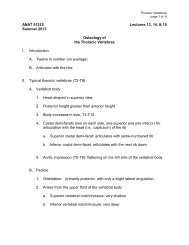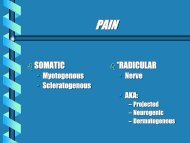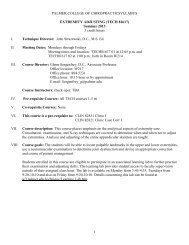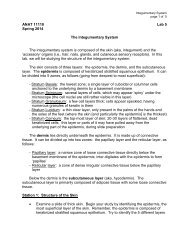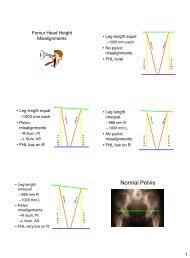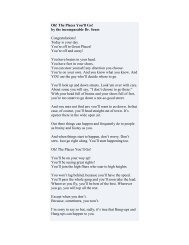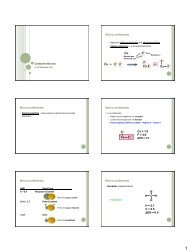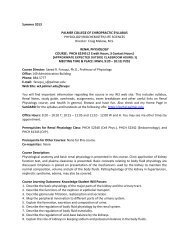Syllabus with labs - Palmer College of Chiropractic, Intranet Home ...
Syllabus with labs - Palmer College of Chiropractic, Intranet Home ...
Syllabus with labs - Palmer College of Chiropractic, Intranet Home ...
Create successful ePaper yourself
Turn your PDF publications into a flip-book with our unique Google optimized e-Paper software.
Attendance PolicyLecture attendance is expected, but not required. It is the students’ responsibility to attend classes andmaintain current on information. If you do not come to class, do not expect tutoring from the instructor. Lab attendancewill be taken. Missed <strong>labs</strong> cannot be made up. Lab reports for those not attending lab will not be accepted.Evaluation ScheduleSee Course CalendarEvaluation ProceduresThree lecture exams and a final exam will be given in multiple choice formats <strong>with</strong> one best answer. The finalexam will be 20% cumulative. The instructor reserves the right to change the testing format. Any change will bediscussed in lecture prior to the exams. Concepts covered earlier in the course may be tied into later examinations. Duringan examination, once the first exam is handed in to the instructor no more exams will be distributed. Your answer sheetis your final answer, so fill it in carefully! You must pass (≥70%) at least one exam in order to pass the class.Announced or unannounced quizzes may be given in class at the discretion <strong>of</strong> the instructor. Clickers will beused to take quizzes – make sure you buy one in the bookstore!Grading StandardThree lecture exams at 40 points each 120 points 54%Final exam 50 points 22%Lecture quizzes 10 points 4%Evidence-based Paper 20 points 9%Lab reports (8 <strong>labs</strong> at 3 points each) 24 points 11%TOTAL 224 points 100%Grading ScaleA ≥89.50% 201-224 total pointsB 79.50-89.49% 178-200 total pointsC 69.50-79.49% 156-177 total pointsF
Student ConductIf you must bring a cell phone to class, please turn the sound <strong>of</strong>f. Verbal and texting conversations areprohibited during lectures and exams. Please be respectful <strong>of</strong> the instructor and your classmates by not carryingon conversations during class. If a student is being distracting a warning will first be given. If the disturbance continues thestudent will be asked to leave the classroom and will need to request readmittance.Student Religious ObservancesIn order to accommodate an individual student’s participation in religious observances, <strong>Palmer</strong> <strong>College</strong> requiresthat the student advises each <strong>of</strong> their instructors, in writing, at the beginning <strong>of</strong> an academic term the holiday and date <strong>of</strong>observance the student is requesting relief from their course(s). This policy does not in any way release the student fromresponsibility <strong>of</strong> satisfying all requirements necessary for the successful completion <strong>of</strong> any course.Academic IntegrityStudents are expected to comply <strong>with</strong> <strong>Palmer</strong>’s Student Code <strong>of</strong> Ethics. Students are strongly encouraged tocarefully read the entire Student Code <strong>of</strong> Ethics as published in the Student Handbook. Cheating, plagiarism, other acts <strong>of</strong>dishonesty and/or any other violations <strong>of</strong> <strong>Palmer</strong>’s Student Code <strong>of</strong> Ethics may result in the filing <strong>of</strong> a charge <strong>of</strong>misconduct under the Student Disciplinary Code as described in the Student Handbook. Sanctions up to and includingsuspension or dismissal from the <strong>College</strong> may be imposed upon students found to have violated the Code <strong>of</strong> StudentEthics. Please refer to the <strong>Palmer</strong> Student handbook or contact the Office <strong>of</strong> Adjudication/Compliance (4 th floor,Administration Building, extension 5476) should you have any questions.Lecture Topic Outline & Learning ObjectivesEvidence-Based Clinical PracticeKnowledge Identify primary and secondary researchContrast absolute risk reduction, relative risk reduction, and odds ratioInterpret number needed to treatIdentify significant OR or RR using confidence intervalsSkills Find an article and write a paper using evidence informed conceptsAttitudes Value the impact evidence informed practice has on clinical practiceChemistry ReviewKnowledgeDescribe intramolecular and intermolecular forcesCompare organic and inorganic moleculesIdentify the structure <strong>of</strong> functional groups including alcohol, aldehyde, ketone, carboxylic acid,amine, etc.Identify the following reactions: redox, dehydration, methylation, phosphorylation, etc.Identify a molecule being reduced or oxidizedMacronutrients, Micronutrients & Buffers (Notes pgs. 17-30; Book chapters 1, 11-13, pgs. 511-515)Knowledge List the three macronutrients & where they are stored in the bodyDescribe the difference between major and trace mineralsExplain why the structure <strong>of</strong> water is biochemically significantExplain the importance <strong>of</strong> pH & buffer systems on blood componentsList functions <strong>of</strong> cell organellesDigestion (Book chapter 2)Knowledge Describe movement through the gastrointestinal (GI) tractDescribe specialized cells <strong>of</strong> the GI tractList enzymes & secretions and describe their functions in digestionDescribe macronutrient digestion in the digestive tractDescribe absorption mechanismsList the absorption location & mechanism <strong>of</strong> macronutrients, vitamins & mineralsDescribe macronutrient transport in the bloodProteins (Book chapter 7, pgs. 567-569)Knowledge Classify each amino acid as polar, nonpolar, acidic, or basicList essential amino acids & what they are metabolized into in vivoDescribe the levels <strong>of</strong> protein structureList ways proteins are denaturedCompare complete and incomplete dietary proteinsNightingale - 3
SkillsAttitudesIdentify the caloric value <strong>of</strong> proteinsList biological functions <strong>of</strong> proteinsDescribe protein digestion, absorption & transportExplain the importance <strong>of</strong> enzymes as biological catalystsDefine the following: apoenzyme, holoenzyme, coenzyme, and c<strong>of</strong>actorDescribe typical reactions <strong>of</strong> the following enzyme classes: oxidoreductases, transferases,hydrolases, lyases, isomerases, and ligasesDescribe enzyme kinetics, including the Lineweaver-Burke plot, K M & V maxCompare competitive and noncompetitive inhibition <strong>of</strong> enzymesDraw Lineweaver-Burke plots for competitive, noncompetitive, and uncompetitive inhibitionValue the biological significance <strong>of</strong> proteins, especially the importance <strong>of</strong> enzymesCarbohydrates (Book chapters 4-5)Knowledge Describe the functions <strong>of</strong> carbohydrates in the bodyIdentify monosaccharide, disaccharide, and polysaccharide structuresList dietary sources <strong>of</strong> carbohydratesIdentify the anomeric carbon, D and L sugars, & α and β bondsDescribe carbohydrate digestion, absorption & transportName pertinent monosaccharide and disaccharide moleculesDescribe the breakdown <strong>of</strong> starch by amylasesCompare the structures <strong>of</strong> starch, glycogen, and fibersExplain the importance <strong>of</strong> blood glucose on health and diseaseIdentify normal and abnormal blood glucose valuesDescribe the impact <strong>of</strong> hormones on blood glucoseCompare Type 1 and Type 2 diabetesExplain the impact <strong>of</strong> glycemic index on blood glucoseList whole grainsLipids (Book chapters 6 & 10)Knowledge List the functions <strong>of</strong> lipids in the bodyCompare fats and oils and list sources <strong>of</strong> bothDifferentiate short, medium, and long chain fatty acidsIdentify saturated, monounsaturated, and polyunsaturated fatty acidsDescribe the effect <strong>of</strong> saturation on physical propertiesDetermine the caloric value <strong>of</strong> lipidsDescribe the impact <strong>of</strong> essential fatty acids on the bodyDefine eicosanoids and describe their role in the bodyIdentify triglycerides (TG), cholesterolExplain the role <strong>of</strong> cholesterol in hormone, bile, & Vitamin D productionDetermine the role <strong>of</strong> phospholipids & glycolipids in the bodyDescribe lipid digestion, absorption & transportDescribe the function <strong>of</strong> lipid-lowering medicationsOxidation/Antioxidants (Book pgs. 368-377; 123-127)Knowledge Describe the mechanism <strong>of</strong> oxidationExplain the effect <strong>of</strong> oxidation on the bodyExplain the effect <strong>of</strong> antioxidants on oxidationNightingale - 4
LABORATORYStudents will be assigned to a lab section during the first 2 weeks <strong>of</strong> class. Each lab session will be two and a halfhours in length during the assigned weeks. Students are required to have their own lab coat, paper masks, gloves, andsafety glasses <strong>with</strong> side shields. Open toed shoes & pants <strong>with</strong> holes are NOT allowed in lab. Lab handouts will begiven out prior to lab. Students will be assigned lab groups <strong>of</strong> 3-4 students during the first lab, which will remain the samethroughout the semester. Each group must turn in a single group lab report at the end <strong>of</strong> each lab period.Lab Topics1. Check-in & lab safety policies2. Enzyme Kinetics 1: Alkaline phosphatase (paired take-home)3. Enzyme Kinetics 2: Biochemistry <strong>of</strong> brewing4. Quantitative triglycerides and cholesterol5. Oxidation & reduction <strong>of</strong> myoglobin6. Serum total protein (STP) quantification7. Electrophoresis <strong>of</strong> serum and plasma proteins8. Quantitative glucose& Check-outLab EvaluationAttendance will be taken at all lab meetings, including check-in and check-out (7 meetings total). Lab reports willbe worth 3 points each (8 <strong>labs</strong>, 24 points total). Take home lab (Lab 2) is due Friday, April 1 st in lab. Late <strong>labs</strong> &electronic copies are not accepted. Labs cannot be made up.Lab Report FormatEach lab the following format:1. Title2. Purpose <strong>of</strong> the experiment – what are you going to do?3. Resultsa. Table <strong>of</strong> all relevant data generated from labb. Summary <strong>of</strong> all experimental results (calculations, tables, figures)4. Discussiona. Answers to questions from lab handout5. Conclusion – general statement that can be concluded from experimental resultsNightingale - 5
Course Calendar (Spring 2011)Sunday Monday Tuesday Wednesday Thursday Friday Saturday27 28 1 2 3 4 56 789101112Faculty In-service Classes begin Chemistry Review Chemistry Review Chemistry Review13 141516171819MEvidence-based Evidence-based Evidence-based Evidence-basedaclinical practice clinical practice clinical practice clinical practiceNO LECTUREr 20 212223242526cNO LECTURE Macro/MicroMacro/MicroMacro/MicroEnzymeshLab 1: Safety27 28Enzymes3 4Digestion29Enzymes5Digestion30Enzymes6Digestion31NO LECTURE7Dietary Supplements1DigestionLab 2 DueLab 3: Brew Chem8Exam 129AprilMay10 11Lipids17 18Lipids24 25NO LECTURE1 2Oxidation/AOX8 9Exam 215 16Proteins22 23Protein Digestion12Lipids19Lipids26Lipid Digestion3Oxidation/AOX10Proteins17Proteins24Carbohydrates13Lipids20Lipid Digestion27Lipid Digestion4Oxidation/AOX11Proteins18Proteins25Carbohydrates14Lipids21Lipid Digestion28Lipid Digestion5Oxidation/AOX12Proteins19Protein26Carbohydrates15LipidsEIP Paper DUE22NO LECTURE29Oxidation/AOXLab 4: Lipids6Chocolate/Degenerative DiscDiseaseLab 5: Myoglobin13ProteinsLab 6: STP20ProteinsLab 7:Electrophoresis27Exam 31623307142128June29 30NO LECTURE5 6Carbohydrates12 13Finals31Carbohydrates7Carb Digestion14Finals1Carbohydrates8Review15 Final Exam –1:05-2:20PMW2102Carbohydrates9Study Day16Finals3CarbohydratesLab 8: Glucose10Finals17Graduation19 20 21 22 23 24 2541118Nightingale - 6
Biochemistry One Frequently Asked Questions1. What is the Biochemistry One website?2. Where is Dr. Nightingale’s <strong>of</strong>fice located?3. What are her <strong>of</strong>fice hours?4. What materials are required for the class?5. What dates are our exams?6. Do we have lab every week?7. When does our first lab start?8. How many points are in the class?9. Do we have any assignments? What are they?10. Can I make up a quiz?11. Can I make up an exam?12. Can I cheat in this class?13. Based on the course learning outcomes, how might this info be useful in my practice?Nightingale - 7



